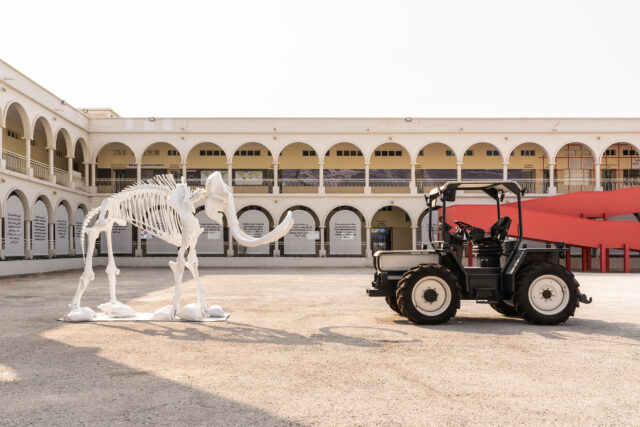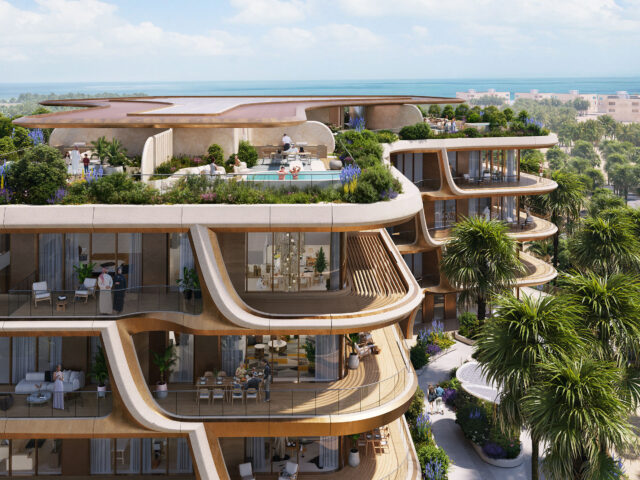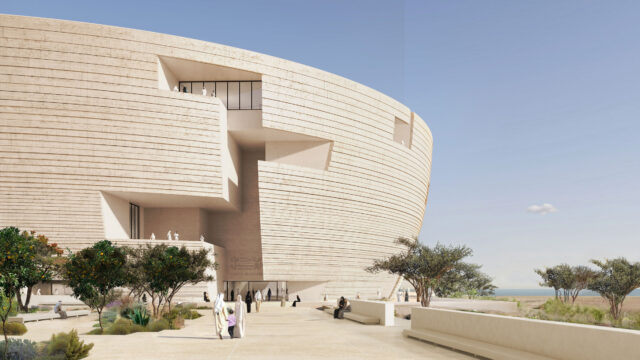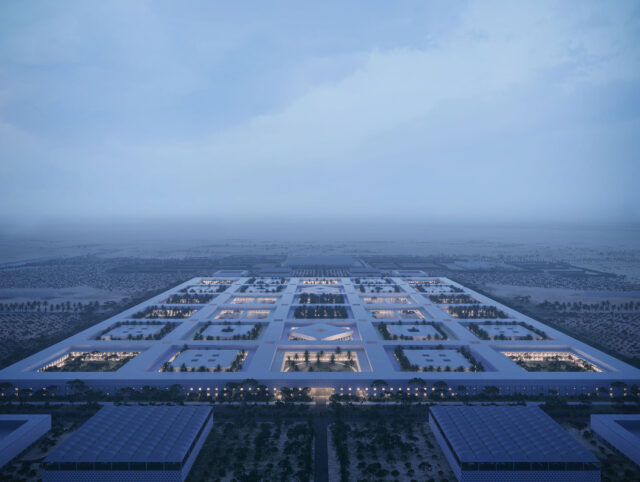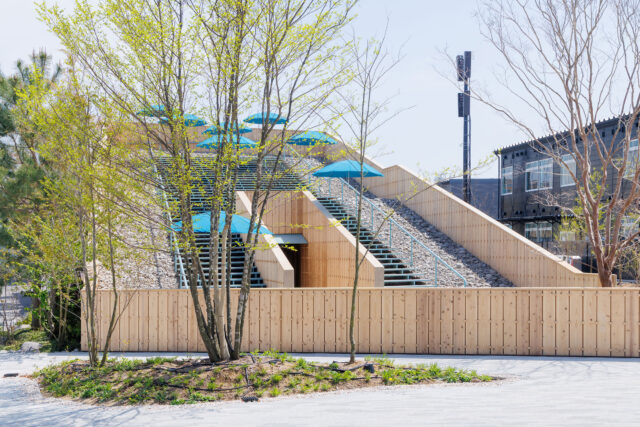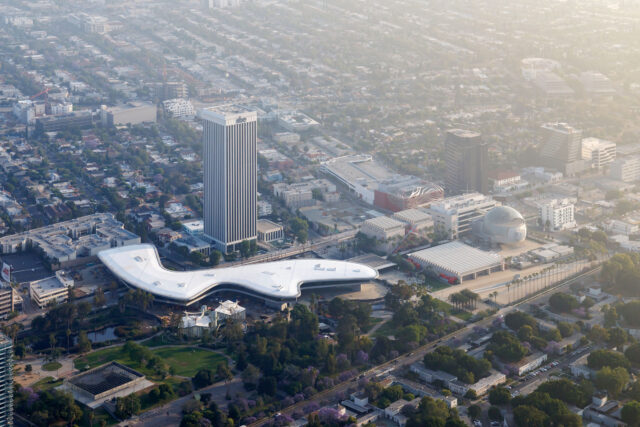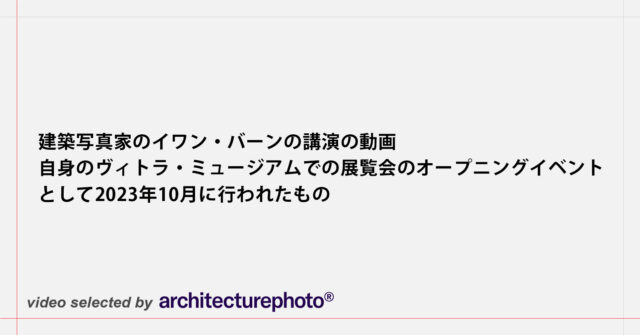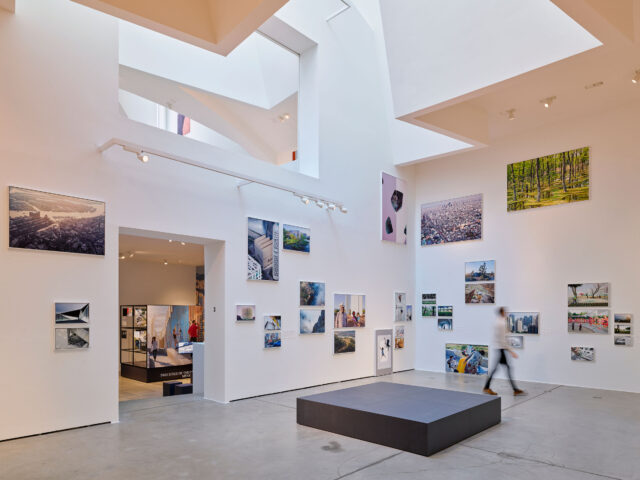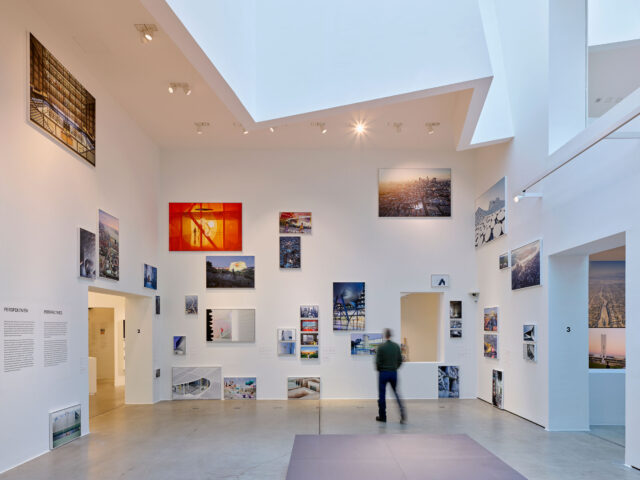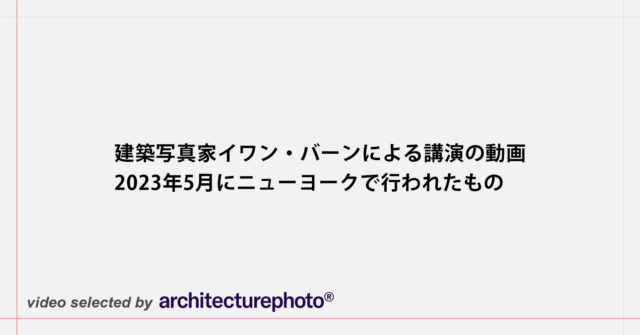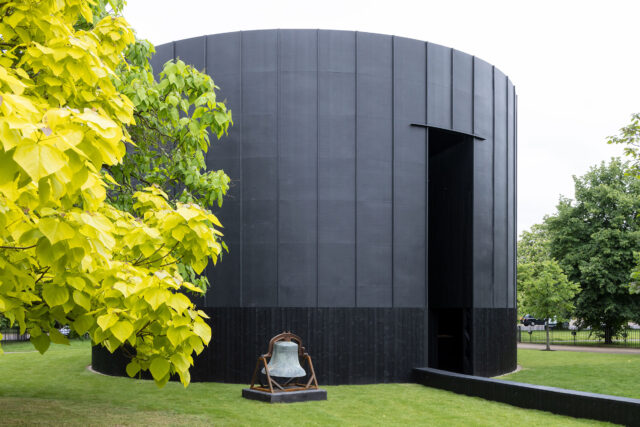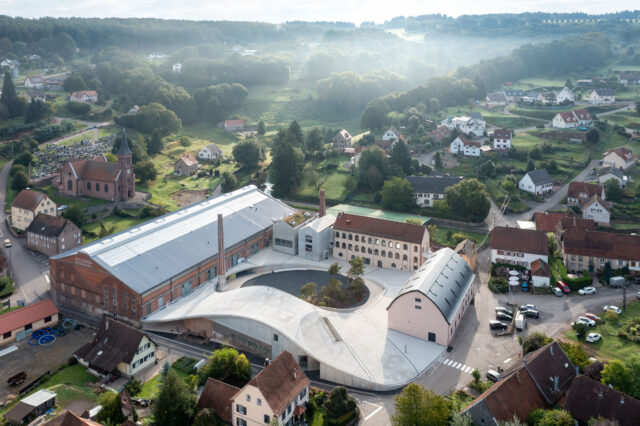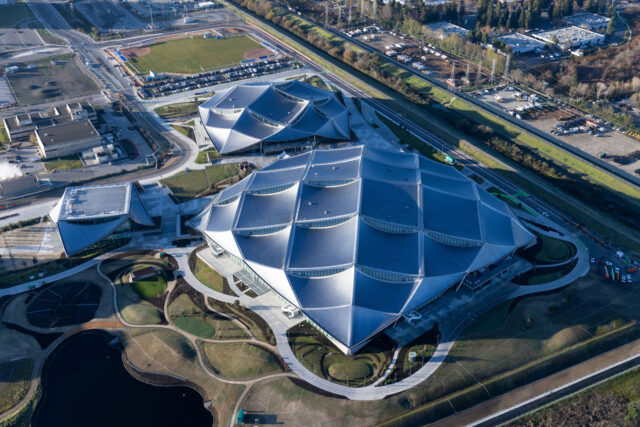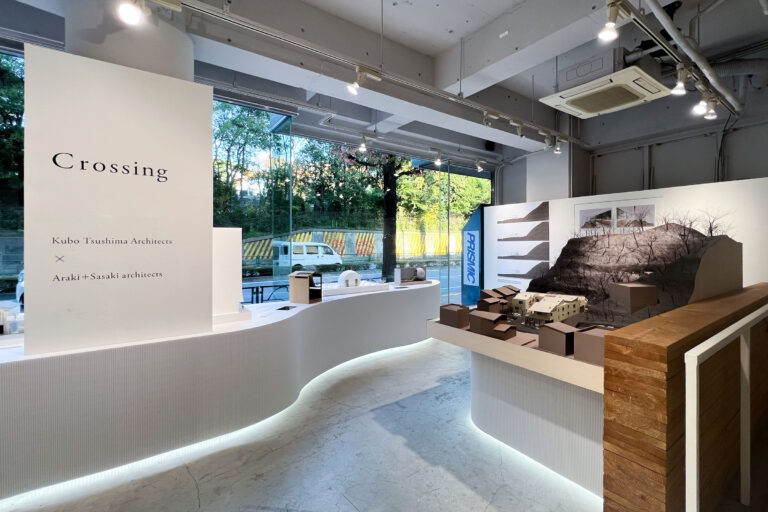
SHARE オラファー・エリアソンによる、カタールでのインスタレーション作品。砂漠が広がる風景の中に設置。半円の支持体と円形屋根で構成された作品で、鏡面天井が訪問者や大地を映し込んで現実認識も触発。冷暖房の無い状況下での人々の周辺環境への感化も促す



オラファー・エリアソンによる、カタールでのインスタレーション「Shadows travelling on the sea of the day」です。
砂漠が広がる風景の中に設置されました。半円の支持体と円形屋根で構成された作品で、鏡面天井が訪問者や大地を映し込んで現実認識も触発する事が意図されました。また、冷暖房の無い状況下での人々の周辺環境への感化も促します。
こちらは、作家によるステートメントの翻訳。
「Shadows travelling on the sea of the day」は、ドーハから北上し、ズバラ砦やアイン・モハメッド村を過ぎて、荒々しい砂漠の風景を走り抜けてたどり着きます。遠くから、地平線上にある小さなインフォーマルな集落や工業地帯のような作品を垣間見ることができるかもしれません。実際に歩いて作品に近づくと、何が見えているのかわからないという不安はもう少し残るかもしれません。砂漠の植物や動物の痕跡、岩石が点在する広大な砂の平面が、四方八方に何キロメートルも広がっている風景。地平線の輝きが作品の外側のリミットなのかもしれません。
しかし、作品に出会うために旅をしてきたのは、あなただけではありません。その涼やかで心地よい影は、日中は砂地をゆっくりと、夕暮れから明け方にかけてはより速く移動します。頭上の天井には大きな鏡が設置されており、忍耐強く観察すれば、この循環する旅路に気づくことができるかもしれません。
見上げると、実は地球や自分自身を見下ろすことになります。上も下も、その空間を共有する他の人たちと共に、砂があなたを包みます。自分の姿を見ながら、腕を伸ばして手を振ったり、足をくねらせたりして、自分の見え方を検証してみましょう。それは、大地と自分がつながっているかどうかの現実確認のようなものです。砂の上にしっかりと立っていると同時に、はるか上方の地面から頭を下げてぶら下がっているような状態です。おそらく、一人称視点と、不安定な三人称視点の自分を行ったり来たりすることになるのでしょう。この視線の振動は、身体の動きと相まって存在感を増幅させ、曲線の構造物は周囲の環境に消えていくかのように、非物質化し、風景となるのです。
左右に展開された彫刻的要素のクラスターを見ると、非常に驚くべき効果に気づくかもしれません。鏡の配列は、物理的に明確で部分的なものを連結し、完璧なものにしているのです。鏡はそれぞれ半円状の支持体を映し出し、完全な円形に仕上げます。隣り合う鏡にも鉄の構造物が映り込み、相互のつながりの海を作り出しています。反射が仮想の構図となり、あなたの動きに合わせて変化します。あなたが知覚する、広大な彫刻の要素、そして来場者が織りなす光景は、超現実的でありながら、完全に地に足の着いたものであるように見えます。
日陰の鏡の下を散策しながら、周囲の環境に感化されていくことを願っています。高速で移動する冷暖房完備の乗り物という保護なしに、ゆっくり歩いてみると、何もない不毛な風景ではなく、砂漠の動物、植物、人間、物語、伝統、文化財、風、眩しい日光、濃い空気、陽炎、半円や輪、痕跡、好奇心、疲労、驚き、などを感じることができるかもしれません。「Shadows travelling on the sea of the day」は、あなたが訪れた時、この空間を動いていたすべてのもの、この自然文化的な風景の中にあなたが存在すること、ここにあるすべてのものを祝福しています。それは、この惑星と再同調することへの招待状です。
アーティストとして活動してきた中で、私は常にコラボレーションとダイアログを強く信奉してきました。私は、2つの方法で、見解の相違、あるいは潜在的な対立に対処してきました。一つは、コミッショナー、キュレーター、コラボレーターとの公私にわたる会話を通じて、もう一つは、私の作品とそれを取り巻くコンセプチュアルな思考を通じて、直接的にです。アートは、美術館であれ公共空間であれ、さまざまな背景を持つ人々が、共通の興味と意見や価値観の違いを認め合いながら空間を共有できる貴重な機会だと思うのです。
「Shadows travelling on the sea of the day」は、暑い砂漠の環境の中で、地元の人々、カタールの住民、美術愛好家、考古学者、観光客などの訪問者が集まり、待ち合わせができる日陰の場所を提供します。鏡のような作品の下側を見上げ、砂漠の中で作品を見回すと、上の反射に自分、他の来場者、そして自分たちが立っている環境が絡み合って見えてきます。
カタールで仕事をするということは、私にとって、自分とは異なる価値観に直面すること、時には根本的に異なる価値観に直面することを意味します。私は、誰もが自由に自己表現する権利、特に性別や性的指向を表現する権利を強く信じていますし、国連が概説する人権を守ることを強く信条としています。カタールでの共同制作を始めるにあたり、私は部外者として、またヨーロッパ人として、これらの価値観をどのようにサポートするのがベストなのかを慎重に判断しています。この「Shadows travelling on the sea of the day」の設置期間中、私のチームは、建築現場においてすべての人権基準が守られるように尽力しました。これは最終的に国全体の標準にならなければなりません。
2017年に初めてカタールで仕事をしたのは、現地でリトルサンのランプを発表する際でした。電気への確実なアクセスがない生活者に太陽エネルギーを届けるリトル・サンは、ドーハの現代アートのためのスペース「ファイアーステーション」で、持続可能性と太陽エネルギーに関するワークショップを開催しました。
約10年前に依頼された「Shadows travelling on the sea of the day」は、4年の歳月をかけて制作されました。そもそも、なぜカタールでのコミッションを引き受けたのでしょうか。広大で傷つきやすい砂漠の風景に魅了され、自分とは異なる文化の中で働くことの可能性に興味を持ちました。砂漠という環境は私にとって馴染みのないものですが、ある意味、私がよく知っているアイスランドの風景と共通するところがあるのです。私は、サッカーの一ヶ月間だけでなく、もっと長い間使える永久的な作品を作ることに重点を置きました。私の彫刻とFIFAワールドカップ・カタール2022の間には、何の芸術的なつながりもないのです。
なぜ、私はその関わりを信じ続けるのか。この地域には、気候変動対策を強化する大きな可能性があり、カタールはここで重要な役割を果たすことができると考えています。この国は、海面上昇や気温上昇など、気候変動の影響を大きく受けると予測されています。同国はパリ協定に加盟しており、2021年には、2030年にメタン排出量を30%削減する「グローバルメタン誓約書」に署名しています。しかし、この国の富は主に石油と、特に液化天然ガスと結びついており、例えばヨーロッパはその一部を増産して輸入することに熱心です。これは、私たち全員が巻き込まれた、非常に複雑な地政学的状況です。
私は数年前から、アート作品の二酸化炭素の排出量について考えています。アート作品は制作され、世界中に輸送され、設置され、また設置されるそして、これらの活動はすべて、二酸化炭素の排出量を伴います。2020年以降、私のスタジオのサステナビリティチームは、廃棄物管理の改善、移動の削減、二酸化炭素排出量の追跡、そして持続可能な実践への投資方法を定義するために、アート制作の全段階を追跡しています。「Shadows travelling on the sea of the day」については、外部企業と連携し、二酸化炭素排出量計算のクロスチェックを実施しています。この試算に基づき、カタールの自然景観の保全に取り組む現地の環境保護団体を支援するために、プロジェクト予算から資金を配分する予定です。
現在カタールの現場で育んでいる創造的なコラボレーション、そして私が作品を通じて提供しようと努めている身体的な体験や自己認識のための空間が、コミュニティや文化を超えた人々の出会いのきっかけになればと願っています。気候の危機は、集団行動と前例のないレベルの国際協力を必要としています。この大きな課題に取り組むために必要な異文化理解は、芸術によって培われると私は信じています。私は、「Shadows travelling on the sea of the day」が、持続可能な実践と気候変動対策について一般の人々がさらに議論を深めるきっかけになることを望んでいますし、カタール美術館のチームと積極的に取り組んでいます。
以下の写真はクリックで拡大します





以下、アーティストによるテキストです。
ARTISTIC STATEMENT by Olafur Eliasson
Shadows travelling on the sea of the day is reached by driving through the rugged desert landscape, northwards from Doha, past Fort Zubarah and the village of Ain Mohammed. You may already glimpse the artwork from afar, situated on the horizon like a small informal settlement or industrial site. When you finally approach the artwork on foot, the uncertainty of what you are in fact seeing may stay with you a little while longer. The landscape – a vast, sandy plane dotted with desert plants, traces of animals, and rock formations – extends around you for many kilometres in all directions. Perhaps the shimmering line of the horizon is the artwork’s outer limit.
Yet it is not only you who have journeyed to meet up with the artwork. Its cool, hospitable shadows travel slowly across the sandy ground during the day and more rapidly at dusk and dawn. Above you, in the ceilings fitted with large mirrors, you may also – with the right amount of patience – detect these cyclical journeys.
Looking up, you come to realise that you are, in fact, looking down – at the earth and at yourself. Above and below, sand envelops you, together with anyone else sharing the space. To test what you see, you might extend an arm and wave to yourself or wiggle a foot while looking at your reflection. It is a kind of reality check of your connectedness to the ground. You are at once standing firmly on the sand and hanging, head down, from a ground that is far above you. You will probably switch back and forth between a first-person perspective and a destabilising, third-person point of view of yourself. This oscillation of the gaze, together with the movement of your body, amplifies your sense of presence, while the curving structures seem to vanish into the surroundings, dematerialising and becoming landscape.
If you look at the clusters of sculptural elements unfolding left and right, you may notice a quite extraordinary effect: the array of mirrors connects and perfects what is physically distinct and partial. The mirrors each reflect their own semicircular support, completing them into perfect circles. The neighbouring mirrors reflect the steel structures as well, creating a sea of interconnections. Reflection becomes virtual composition, changing as you move. What you perceive – an entanglement of landscape, sprawling sculptural elements, and visitors – seems hyperreal while still completely grounded.
I hope you will become sensitised to the surroundings as you meander beneath the shady mirrors. Walking slowly – without the protection of a fast-moving, airconditioned vehicle – you may be able to take in a landscape that is not barren and empty but comprises desert animals, plants, and human beings; stories, traditions, and cultural artefacts; wind, glaring sunlight, thick air, and shimmering heat; semicircles and rings; traces and tracks; and curiosity, fatigue, and wonder. Shadows travelling on the sea of the day is a celebration of all that is here; of everything moving through the space at the time of your visit, of your presence within this naturalcultural landscape. It is an invitation to resync with the planet.
***
CONTEXT STATEMENT by Olafur Eliasson
Over the course of my working life as an artist, I have always been a strong believer in collaboration and dialogue. I have approached diverging points of view – or even potential conflicts – in two ways: through the conversations, some public, some private, that I have with commissioners, curators, and collaborators; and directly through my artworks and the conceptual thinking surrounding them. I think art offers a rare opportunity for people from a wide range of backgrounds to share a space – whether in a museum or in public space – while acknowledging both shared interests and differences of opinion and of values.
Shadows travelling on the sea of the day provides areas of shade where visitors – locals, residents of Qatar, art lovers, archaeologists, and tourists – can gather and meet up in the hot desert surroundings. Looking up at the mirrored undersides of the artwork and around at the artwork in the desert surroundings, they see themselves, the other visitors, and the environment in which they are standing entangled in the reflections above.
For me, working in Qatar has meant entering into a context where I am confronted with values that are different from my own – sometimes radically so. I adamantly believe in the right of everyone to express themselves freely, in particular with regard to their gender and sexual orientation, and I am a strong believer in upholding human rights, as outlined by the UN. Entering into a work collaboration in Qatar, I am careful, as an outsider and as a European, to evaluate how I can best support these values. Throughout the installation of Shadows travelling on the sea of the day my team was dedicated to ensuring that all human rights standards were upheld on the building site. This must ultimately become the standard throughout the country.
I first worked in Qatar in 2017, on a presentation of my Little Sun lamps there. Little Sun, which brings solar energy to people living without reliable access to electricity, hosted workshops about sustainability and solar power at a space for contemporary art in Doha, called Fire Station.
Commissioned almost a decade ago Shadows travelling on the sea of the day has taken four years to produce. Why did I accept a commission in Qatar to begin with?
I was fascinated by the vast and vulnerable desert landscape and interested in the possibility of working in a different culture from my own. The desert environment is unfamiliar to me but in some sense it shares certain qualities with the Icelandic landscape that I know so well. I focused on making a permanent artwork, with a life expectancy that extends far beyond a single month of football. There is no artistic connection between my sculpture and the FIFA World Cup Qatar 2022.
Why do I continue to believe in that engagement? I think there is great potential for intensified climate action in this part of the world, and Qatar can play a critical role here. The country is predicted to be hit hard by the consequences of climate change, including rising sea levels and increased temperatures. The country is a signatory of the Paris Agreement and, in 2021, signed the Global Methane Pledge to reduce methane emissions by 30% in 2030. Yet the wealth of the country is primarily bound up with oil and, not least, liquefied natural gas, some of which Europe, for instance, is keen to import at increased levels. This is a highly complex geopolitical situation in which we are all entangled.
For several years now, I have been considering the carbon footprint of art – artworks are produced, shipped to locations worldwide, installed and de-installed again, and all these activities have a carbon footprint. Since 2020, my studio’s sustainability team has tracked all stages of art-making to improve waste management, reduce travel, and track carbon footprints; and to define ways of investing in sustainable practices. For Shadows travelling on the sea of the day, we are working with an external company to cross-check our calculation of its carbon footprint. Based on this calculation we will allocate funds from the project budget to support local environmental groups that work to preserve Qatar’s natural landscapes.
I hope that the creative collaborations that I am currently nurturing on site in Qatar – and the embodied experiences and space for self-reflection that I strive to offer in my artwork – will provide means for people to meet each other across communities and cultures. The climate crisis requires collective action and an unprecedented level of international cooperation. It is my belief that art can help cultivate the transcultural understanding necessary to tackle this enormous task. I aspire for Shadows travelling on the sea of the day to be a prompt for further public discussion on sustainable practices and climate action – which I am actively working on with the teams at Qatar Museums.


